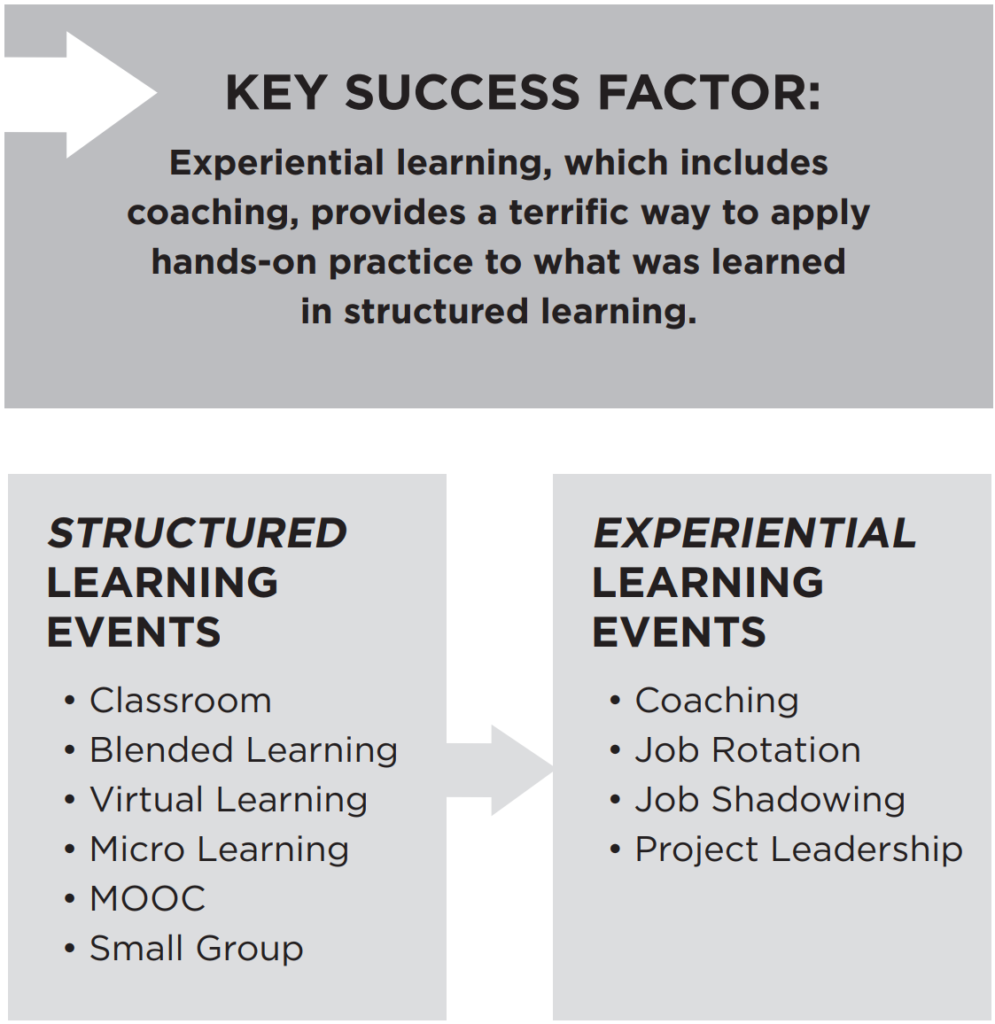Coaching Activates and Retains Learning and Development

Leadership development in most organizations takes the form of structured learning. Leaders move from their job environment to a formal classroom experience where they are exposed to ideas and thinking delivered in a variety of channels. These channels include traditional classroom, virtual learning, micro learning (or bite-sized learning modules delivered as needed), and small-group learning. While effective for some leaders, the largest complaint heard from structured learning is that retention and application of the learned concepts quickly dissipate when the leader returns to their regular job.
Experiential learning, which includes coaching, provides a terrific way to apply hands-on practice to what was learned in structured learning. Activities such as coaching, job rotation, job shadowing, and project leadership create a real-world laboratory where leaders can practice their skills.

Coaching can be an effective way to build on skills learned in a more structured environment, but only if organizations make it a purposeful part of the leadership development agenda. All too often, organizations see coaching as a perk for higher-level leaders or those who won’t attend a class, while everyone else receives structured learning events. Unlike other experiential activities, coaching provides direction and support before and after on-the-job practice. In this way, coaching sessions become goal-setting and reflection sessions for leaders to make course corrections along the way to higher performance. No other experiential intervention creates this kind of dynamic change process.
Building coaching and other experiential learning events into the leadership development agenda can create exceptional leadership investment value for the organization for three reasons:
1. Coaching builds on prior learning and self-discovery from other leadership development activities.
Clients and coaches can discuss key learnings from structured experiences and then create personalized plans to change behavior back on the job. Many clients like the idea of having a coach hold them personally accountable for trying the new concepts and competency skills learned in a session. In this way, coaching keeps the leadership learning momentum going.
Example: A multi-national financial company selected 25 high potential leaders to attend a week-long leadership development retreat in Europe. Top business-school facilitators were recruited to facilitate the session. The 25 leaders learned many practical new skills and received very useful feedback about their own leadership styles. When the leaders returned home after the retreat, they were each assigned an executive coach to help them prioritize their learning and create an ongoing action plan based on the feedback they received. Without the opportunity to receive coaching, most of the leaders would likely have turned their immediate focus to unattended email and problems awaiting their return. The investment in their development may have never been fully realized.
2. Coaching provides long-term practice and retention versus point-in-time learning.
Long after workshops and seminars are forgotten, coaching sessions provide ongoing skill practice with periodic feedback. Combining coaching with more traditional leadership development activities can magnify the return on investment for all initiatives.
Example: Using the same example listed above, the 25 high-potential leaders were asked by their coaches to create action plans for their desired change and report back on their activities over the next six months. Their coaches continued to challenge them to think creatively and boldly about how they wanted to make positive changes in their leadership strategy. Many of the 25 leaders reported that without this challenge, they would not have achieved the level of performance that they did.
3. Coaching helps identify gaps and desired behavior changes that may not be included in the organization’s chosen leadership competencies.
It would be too simplistic to say that the ten to twelve competencies that organizations see as most important are broad enough to cover all development needs. Coaching can uncover the finer nuances of needed behavior change while still supporting the overarching organizational leadership goals.
Example: A consumer products company had identified ten leadership competencies they desired in all leaders. These included attributes like integrity, thinking like a customer, courage, and leading by example. One top leader, working with an executive coach, discovered that she had an opportunity to become better at delegating for growth and accountability. While delegation was not specifically one of the core competencies, the leader’s coach was able to help her implement actions to improve her skills, which supported the broader competencies.
Organizations that build coaching into their leadership development agenda are often able to leverage their structured learning in a much more effective way. By intentionally linking executive coaching to the overall leadership development agenda, an organization is much more likely to ensure lasting behavior change that creates positive results.
How can coaching help your organization achieve its leadership development agenda?
##
This post is an excerpt from the book, Accelerating Leadership, co-authored by Lance Hazzard and Eric T. Hicks, Ph.D., published in June 2019. Information regarding how and why organizations use executive coaching to accelerate leadership development is included in the book. More information can be found at www.acceleratingleadershipbook.com
Lance Hazzard, CPCC, ACC, is a certified Intelligent Leadership Executive Coach helping people and organizations successfully achieve what’s next. He is Executive Coach and President at Oppnå® Executive & Achievement Coaching. Find out more about Lance and Oppnå® Coaching at www.oppnacoaching.com